Winter 2020 SDJ: Aotearoa New Zealand, Out Now!
December 21, 2020
Surface Design Association is excited to announce Aotearoa New Zealand, our winter 2020 edition of Surface Design Journal, will be arriving in mailboxes shortly! This Journal provides a glimpse into the creative community of Aotearoa New Zealand. From vibrant fabric sculptures and the wool industry, to the conservation of Māori Textiles, readers will find a wonderful account of the diverse communities that flourish across the island of Aotearoa New Zealand.

Here’s a preview of what you’ll discover:
“Jim Cooper: A Riotous Practice” by Moira White examines Cooper’s art, which is “optimistic, floral and geometric, brilliant and cheering. It has a physical presence marked by color, texture and composition, based on cutting, stitching and juxtapositioning. Most of all, it embodies kindness.”

Jim Cooper 13th Floor Buddha 2015, knit fabrics, canvas backing, machine sewn, 65″ x 43″. Photo: Scott Reeves.
“Textiles Through an Indigenous Lens: Recognizing how our Colonial Past has Shaped the way we use Fiber Throughout Moana-nui-a-kiwa” by Montess Hughes & Sonya Withers “provides a thread into the ocean of textiles that materialize the essence of Te Moana-nui- a-kiwa. As people of Moana-nui-a-kiwa, textiles represent both our lineage and connection to our ancestors through time and space. To illustrate our shared histories, we will be discussing two textile types commonly found in museums across the globe: Ngā Korowai and Le Siapo.”

Violinist David Maha opened the 2010 Miromoda Showcase at New Zealand Fashion Week wearing a kākahu woven by Diggeress Te Kanawa. Photo: Miromoda – the Indigenous Māori Fashion Apparel Board.
“A Love Letter to Rugs: Reading Vita Cochran’s Rag Rug Practice” by Grace Lai looks at the work of Vita Cochran whose “practice plays homage to women’s craft of the past, particularly those popular in the 1930s and 1940s. In this vein, Cochran makes everything by hand and practices the artform of reuse. The material of Cochran’s work has usually led a past life, whether with others or herself.”
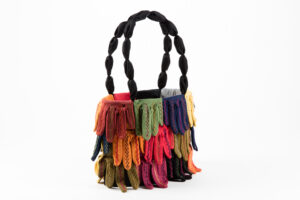
Vita Cochran Hand Work Bag 2007, twelve pairs of nylon gloves, hand stitched, 16″ x 10″ x 6″. Photo courtesy of Auckland War Memorial Museum.
“Sharing Human Warmth with Wool in New Zealand” by Olive Riley & Kelly Olaturji spotlights the duo’s mission to “make wool more accessible to New Zealand families and communities through CommonKind—a ‘buy one, give one’ social enterprise aimed at spreading joy and warmth. The concept is perhaps a little bold: creating premium, bright, fun, woolen blankets with margins that cover the cost of a blanket for a child living in material hardship, while maintaining sustainable environmental and economical values.”
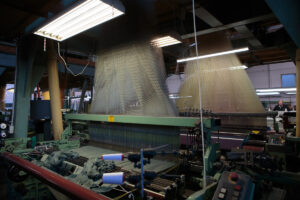
Dobby and Jacquard looms with the ability to produce fabrics of different thicknesses and widths. Photo: Inter-Weave.
This Journal’s Exposure department features a gallery of NZ-based SDA members: Donna Campbell, Olivia Edginton, Viv Davy, Christine Keller, and Tallulah Farrar.

Donna Campbell (Ngā Puhi & Ngāti Ruanui) Hinenuitepō I–The one who holds the long endless night. Pendant – Mother of Pearl and natural fiber 2018, New Zealand harakeke, synthetic dyes, handwoven (traditional Māori process), plants are harvested, prepared and woven according to cultural protocols. Model: Nadia Jones. Waikato Museum Collection, Hamilton, New Zealand.

Olivia Edginton Panelled Wool Rug 2020, 100% New Zealand Wool, rug tufted, 39″ x 39″. Photo by the artist.
Emerging Voices spotlights the works of both Susie Cho and Hanna Shim’s creative practices. Cho uses knitted forms to “encourage a more inquisitive pictorial and sensory engagement with objects as haptic artefacts.” Shim’s work “investigates the materiality of soft materials—how the style transfigured from the 20th century image of rationality; its anti-form quality; and the hierarchy of “low” craft versus the “high” art world which is derived from a gendered bias.”

Susie Cho Dishwasher versus Tea Towel 2019, mercerised cotton, murelon yarn, knitted buttons, Shima Seiki knitting machine, 13″ x 15.5″. Photo: Annamarie Ott.
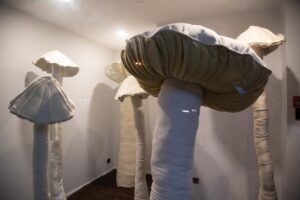
Hanna Shim Mushroom Room (installation) 2020, synthetic fabric, polyester fill, aluminium tube, wire, butyl. Whitespace contemporary art.
Made Aware: “Whatiri and AKA” by Matariki Williams looks at the work of the collaborative group Mata Aho, a quartet of four wāhine Māori (Erena Baker—Te Atiawa, Ngāti Toarangatira, Ngāti Raukawa; Sarah Hudson—Ngāti Awa, Ngāi Tūhoe; Bridget Reweti—Ngāti Ranginui, Ngāi Te Rangi; Dr Terri Te Tau—Ngāti Kahungunu, Rangitāne ki Wairarapa) “who produce large-scale, often site-specific works. Their work is made via a wānanga model in which they spend extended amounts of time together wherein strong ideas are accelerated and other ideas are parked for later.”

Mata Aho Collective AKA (installation) 2019, marine rope, steel, whatu. National Gallery of Canada. Photo courtesy of Mata Aho Collective.
Informed Source: “The Conservation Of Māori Textiles in Aotearoa New Zealand” by Kate Blair & Rangi Te Kanawa looks at “the conservation of historical and cultural items aims to preserve our collective heritage for current and future generations. Emphasis is generally placed on physical preservation, but in the last 25 years more attention has been given to intangible cultural aspects of heritage preservation, such as knowledge of weaving practices, materials and indigenous knowledge systems.”

(L to R) Maureen Lander, Awhina Tamarapa, Kahutoi Te Kanawa, Te Hemo Ata Henare, Rangi Te Kanawa, Christina Hurihira Wirihana, and Matekino Lawless, Taumata Māreikura for Te Awe project. Photo: Awhina Kerr. Auckland War Memorial Museum Tāmaki Paenga Hira, 2018.
First Person: Veronica Bell: “Always though, notions of identity; perceptions of self, culture and history have been the subject matter of my work. As a white descendent of settler culture in Te Waipounamu South Island, I seek to address the uncomfortable truths that emerge from this inquiry. By working with textiles, I am able to use subversion and play as ways to present these knowledge; a soft glove for hard truths.”
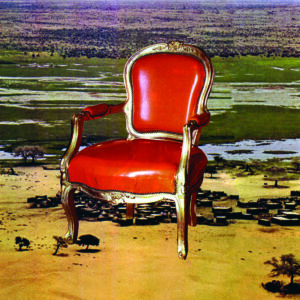
Victoria Bell Not At Home (gold chair view) 2010, double-sided digital print, 8.25″ x 8.25″.
In The Studio: Christopher Duncan: “My work usually had a quiet, subtle aspect to it. I would limit myself to only a few colors or rely on color for small detailing. This segue into linen led to the development of a narrative of structure and texture.”
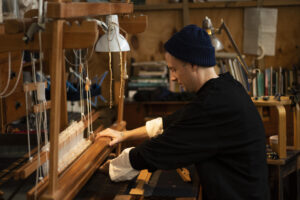
Christopher Duncan weaving at his studio, 2020. Photo: Joshua Crocombe.
Legacy: “The Pacific Sisters: Frocking it up” by Ane Tonga: “For more than 25 years, the Pacific Sisters have been a galvanizing force in Aotearoa New Zealand. Originating on the fringes of mainstream art and fashion, the group’s interdisciplinary practice is wide ranging, from fashion shows and fashion editorials as well as moving image and performance. The Pacific Sisters members include Selina Forsyth (Sāmoan), Suzanne Tamaki (Tūhoe), Nephi Tupaea (Ngāti Katoa), Rosanna Raymond (NZ Sāmoan/European), Ani O’Neill (Cook Islands Irish), Jaunnie Ilolahia (Tongan), Lisa Reihana (Ngā Puhi), Henry Taripo (Cook Islands) and Feeonaa Clifton (Wall) (NZ/Sāmoan/Sweden/Germany). Their fluid notions of sisterhood have been a catalyst for connections across a host of extended networks that, at one point, grew to more than 500 members.”

Pacific Sisters: Feeonaa Clifton (Wall), Henry Ah-Foo Taripo, Ema Lyon, Ani O’Neill, Rosanna Raymond, Jaunnie ʻIlolahia, Suzanne Tamaki, Lisa Reihana. Acti.VA.tion Pacific Sisters Fashion Activists, Te Papa Tongawera, 2018. Photo: Kerry Brown.
Spotlight on Education looks at Ngā Pae Māhutonga School of Design by Faith Kane and Dunedin’s LoomRoom by Christine Keller.
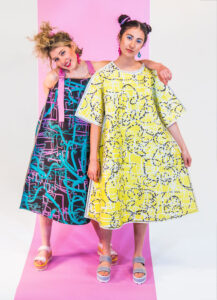
Lucy Polson Out of Bounds 2018, digitally printed dresses, enhanced with the Out of Bounds App.

Gill Johnson preparing floor loom with hand spun mohair/ merino, Dunedin’s LoomRoom, 2019. Photo: Christine Keller.
In Review looks at three different exhibitions from around Aotearoa New Zealand: DUIRVIAS reviewed by Robyn Maree Pickens, Bush coat reviewed by Grace Ryder, and All the careers I have ever considered doing in order to finance my art career reviewed by Abby Cunnane.
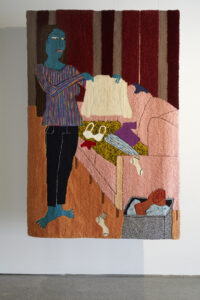
Claudia Kogachi Nanny 2020, machine tufted rug, 60″ x 84.25″. Photo: Sam Hartnett.
To buy a copy of Aotearoa New Zealand, go to the SDA Marketplace, or you can check out a free digital sample on our SDA Journal page.

1 Comment
Marianne Doczi says
December 29, 2020 at 3:02 am
Kia Ora, as an ex-pat living in Australia, great to see this edition of the SDA journal focusing on Aotearoa New Zealand. And ... the nation has two islands, Te Ika a Maui North Island and Te Wai Pounamu South Island. Nga mihi nui
Related Blog Articles
No related blog articles yet.